Master100A MPPT solar regulator, 12V 24V 36V 48V charge controller 4000W
- Loading Port:
- China main port
- Payment Terms:
- TT OR LC
- Min Order Qty:
- 10 unit
- Supply Capability:
- 9999 unit/month
OKorder Service Pledge
OKorder Financial Service
You Might Also Like
High efficient MPPT 48v 100a solar charger controller
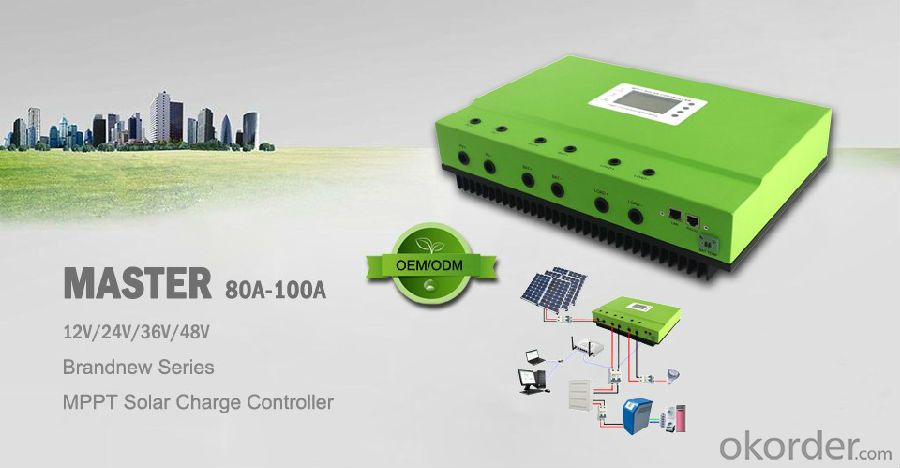
Products Advantages
1. MPPT charge mode,conversion efficiency up to 99%;
2. Maximum PV input is DC 150V;
3. Support all kind of batteries, non-normal type can be set on PC software;
4. Three stage charge mode: fast charge,constant charge,floating charge);
5. With temperature sensor;
6. Anderson connection port, avoide reverse connection;
7. RS232 and LAN communication port, free PC software;
8. Intelligent design,the device can be upgraded online;
9. The devices can suffer the temperature not less than 105°C;
10. Perfect protection:input lowvoltage,input overvoltage,input polarity reversal,
output over voltage,short-circuit over temperature;
11. Unlimited parallel;
12. 5 discharge mode;
13. LCD and LED show all kinds of parameter;
14. CE,ROHS,FCC certifications approved.The device also can support to pass the other certifications;
15. 2 years warranty and 3~10 years extended warranty service also can be provided.
Connection Diagram
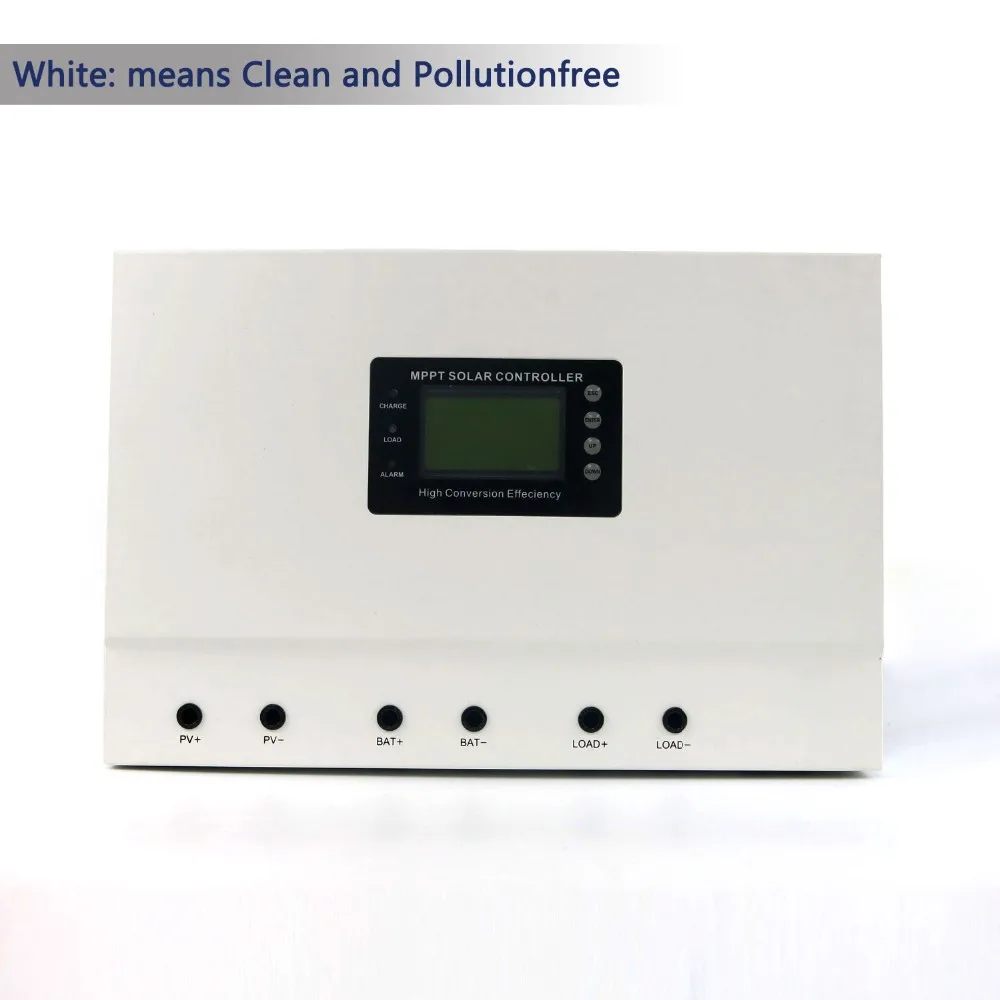
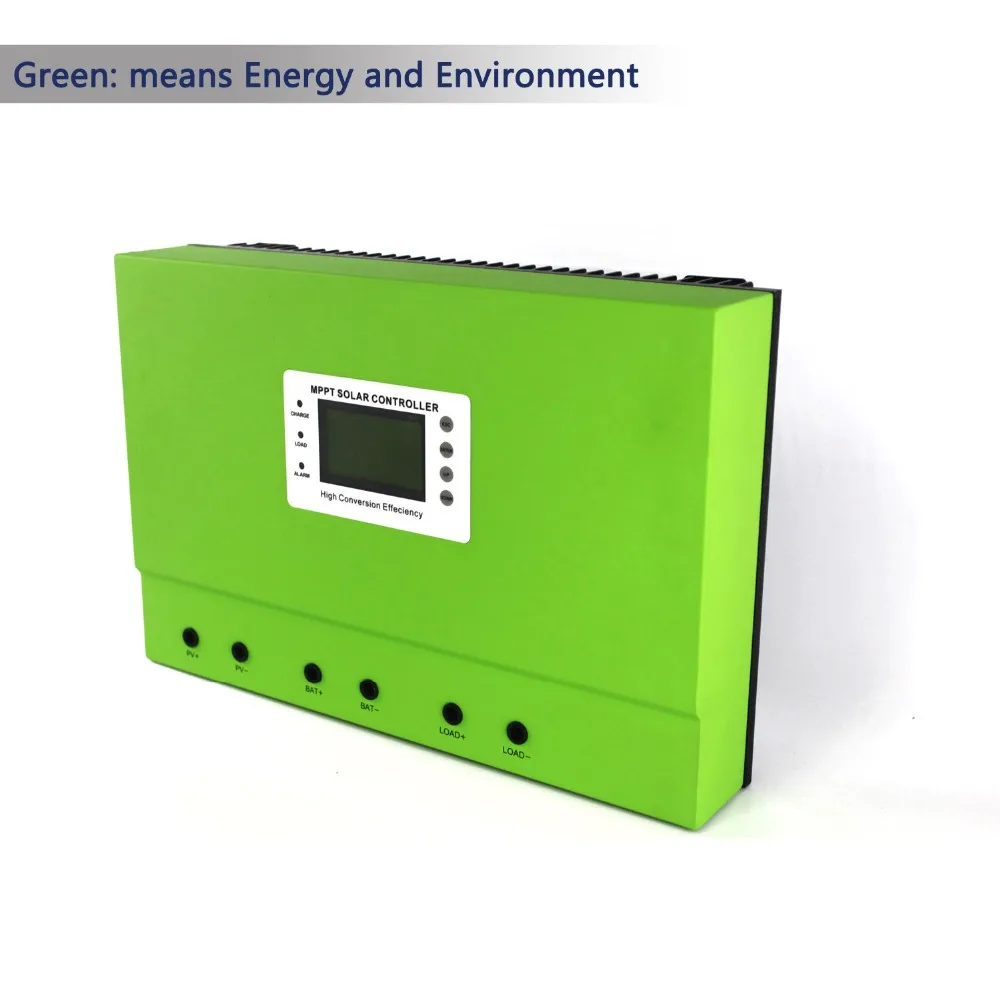
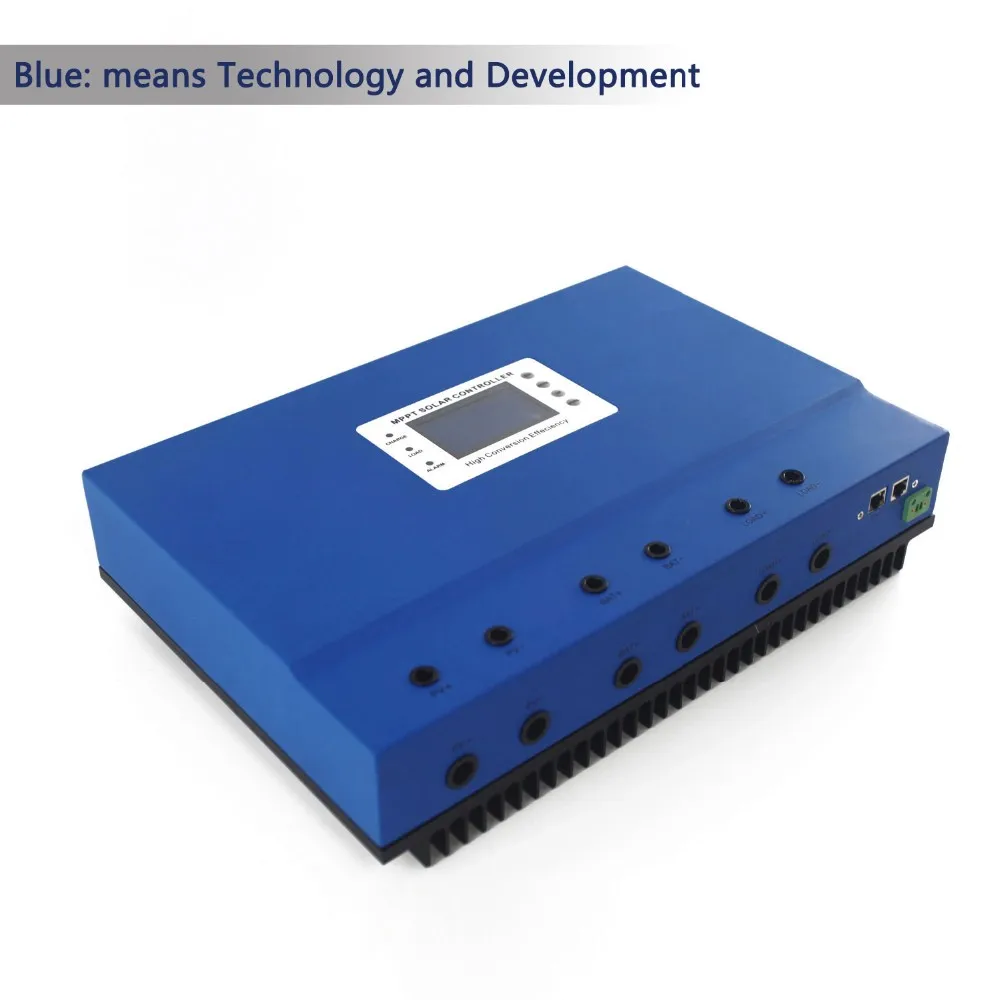
Upper PC Software
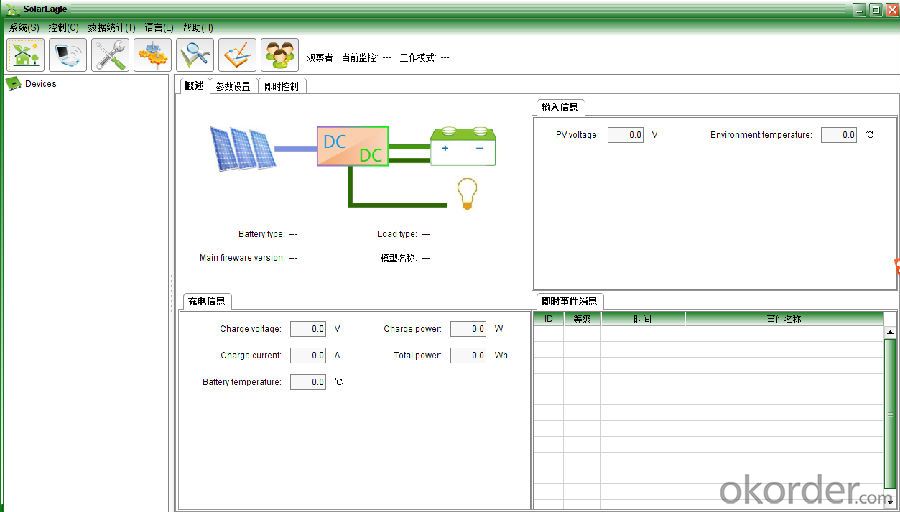
Test Software
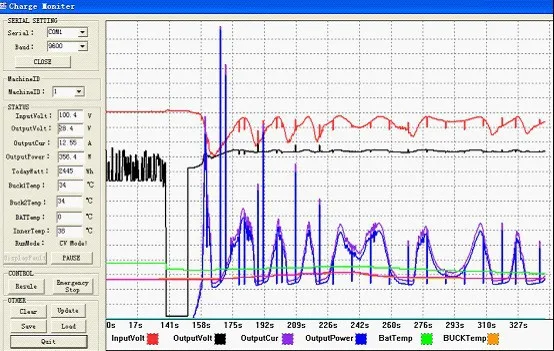
Parameter
MPPT controller Model: Master1-80A/100A Series | 80A | 100A | |
Charge Mode | MPPT(Maximum Power Point Tracking) | ||
Charge Method | 3 stages: fast charge(MPPT),constant voltage, floating charge | ||
System Type | DC12V/24V/36V/48V | Automatic recognition | |
Conversion Efficiency | DC12V/24V/36V/48V | 96.5% ~99% | |
PV Modules Utilization Rate | DC12V/24V/36V/48V | ≥99% | |
PV Input Characteristics | |||
MPPT Working Voltage and Range | 12V system | DC22V~DC150V | |
24V system | DC34V~DC150V | ||
36V system | DC50V~DC150V | ||
48V system | DC60V~DC150V | ||
Input Over voltage Protection Point | DC12V/24V/36V/48V | DC150V | |
Rate charge current | DC12V/24V/36V/48V | 80A | 100A |
Max. PV Power | 12V system | 960W | 1200W |
24V system | 1920W | 2400W | |
36V system | 2880W | 3600W | |
48V system | 3840W | 4800W | |
Charge characteristic | |||
Selectable Battery Types (Default type is GEL battery) | DC12V/24V/36V/48V | Sealed lead acid, vented Gel, NiCd battery (Other types of the batteries also can be defined) | |
Temperature Compensation | DC12V/24V/36V/48V | 14.2V-(The highest temperature-25℃)*0.3 | |
Discharge characteristic | |||
Setting Control | Controller or PC software | ||
Max discharge current | DC12V/24V/36V/48V | 100A | |
Output control mode | Double-time control, ON/OFF mode, PV voltage control, PV&Time control | ||
Physical | |||
Communication Port | RS232 and LAN | ||
Measurement D*W*H (mm) | 420*280*102 | ||
N.G(kg) | 7.5 | ||
G.N(kg) | 8.5 | ||
Color | Blue, Green, White (optional) or OEM | ||
Environment | |||
Humidity | 0~90%RH ( no condense) | ||
Altitude | 0~3000m | ||
Operating Temperature | -20℃ ~ +40℃ | ||
Storage Temperature | -40℃ ~ +75℃ | ||
Atmospheric Pressure | 70~106kPa | ||
Certifications |
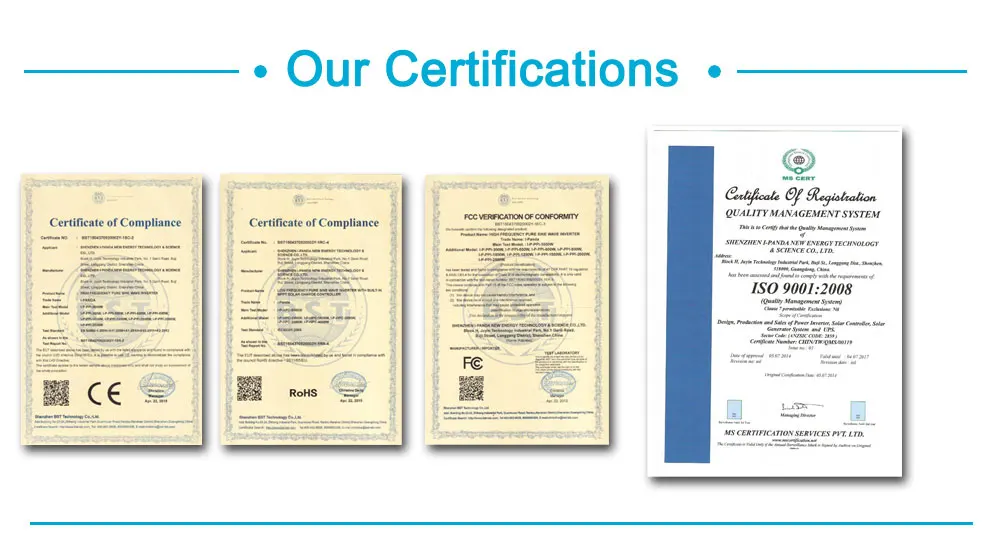
F&Q: |
Q1. How to ensure and monitor the products quality?
A1: We have established a perfect Quality Management System, In strict
accordance with ISO9001: 2008 quality system and ISO14001 environment system for quality assurance management;
Our ISO9001:2008 Quality System certificate encoding: CHIN/TW/QMS/00119;
Our ISO14001 Environment System certificate encoding: CHIN/TW/EMS/00028;
Q2. What is the warranty of products?
A2: The warranty period of different products are different; 5 years, 3 years, 2 years, 1 years; More details please refer to the product specification or manual; we will provide free life-long technical support ;
Q3. What is the difference between MPPT&PWM?
A3. MPPT charging mode, peak efficiency up to 99%, saving 30%~60% solar panel than traditional PWM controller.
- Q:Can a solar controller be used with a solar-powered security gate system?
- Yes, a solar controller can be used with a solar-powered security gate system. A solar controller is designed to regulate and optimize the charging of batteries from solar panels, ensuring that the batteries receive the correct voltage and current. This is essential for a solar-powered security gate system as it relies on stored energy from batteries to operate during periods of low sunlight or at night. The solar controller helps manage the charging process efficiently, maximizing the system's performance and longevity.
- Q:Can a solar controller be used with a solar-powered recreational facility?
- Yes, a solar controller can be used with a solar-powered recreational facility. A solar controller regulates the flow of electricity from the solar panels to the battery bank, ensuring efficient charging and preventing overcharging or damage to the batteries. It is an essential component in managing the power supply for a solar-powered facility, including recreational facilities such as campsites, sports complexes, or outdoor activity centers.
- Q:What is the purpose of the maximum power point tracking feature on an MPPT solar controller?
- The purpose of the maximum power point tracking (MPPT) feature on an MPPT solar controller is to optimize the efficiency and output of the solar panel system. Solar panels have a specific voltage and current at which they can generate the maximum power output, known as the maximum power point (MPP). However, the MPP of the solar panel can vary due to changes in temperature, shading, and other environmental factors. The MPPT feature constantly monitors the voltage and current of the solar panel and adjusts the operating point to ensure that it operates at the MPP. By dynamically adjusting the voltage and current, the MPPT controller maximizes the power output from the solar panel and ensures that the maximum available energy is harvested from the sunlight. This feature is crucial in situations where the solar panel is subject to varying environmental conditions, as it allows the system to adapt and continuously operate at its optimum efficiency. By tracking the MPP, the MPPT controller ensures that the solar panel system operates at its highest possible power output, resulting in improved energy production and overall system performance. Furthermore, the MPPT feature also enables the solar panel system to be more compatible with different battery charging requirements. It allows for the conversion of excess energy that would otherwise be lost as heat, into usable energy for charging batteries or powering other devices. This capability makes MPPT solar controllers more versatile and efficient in various applications, such as off-grid systems, hybrid systems, and grid-tied systems with battery backup. In summary, the purpose of the MPPT feature on an MPPT solar controller is to optimize the power output of the solar panel system by continuously tracking the maximum power point. It ensures that the system operates at its highest efficiency, maximizes energy production, and improves compatibility with battery charging requirements.
- Q:How do I troubleshoot common issues with a solar controller?
- To troubleshoot common issues with a solar controller, you can follow these steps: 1. Check the connections: Ensure all cables and connectors are securely plugged in and free from any damage or corrosion. 2. Examine the solar panels: Inspect the panels for any physical damage or debris that may be obstructing sunlight. Clean them if necessary. 3. Verify battery connections: Ensure the battery terminals are clean, tight, and properly connected. Loose or corroded connections can affect the controller's performance. 4. Check battery voltage: Measure the voltage of the battery using a multimeter. If it's significantly lower than expected, the battery might be faulty or needs charging. 5. Inspect the controller display: Look for error codes or warning messages on the controller's display. Refer to the manufacturer's manual to understand the meaning behind these indications. 6. Reset the controller: Some issues can be resolved by resetting the controller. Disconnect the solar panels and battery, wait for a few minutes, and then reconnect them. 7. Monitor the charge controller: Observe the controller's behavior during different times of the day. If it's not charging the battery or regulating the voltage properly, it might be defective and need replacement. 8. Consult the manufacturer: If the above steps don't resolve the issue, contact the manufacturer or consult their customer support. They can provide specific troubleshooting advice or recommend professional assistance if needed.
- Q:How does a solar controller prevent overloading of the solar panel system?
- A solar controller prevents overloading of the solar panel system by regulating the flow of electricity between the solar panels and the battery bank. It monitors the voltage and current produced by the solar panels and adjusts the charging rate to prevent excessive charging, which can damage the batteries and other components of the system. Additionally, it disconnects the solar panels from the battery bank when the batteries are fully charged, preventing overcharging and potential damage to the batteries.
- Q:How does a solar controller handle shading on solar panels?
- A solar controller handles shading on solar panels by implementing a technique called Maximum Power Point Tracking (MPPT). This technology allows the controller to constantly monitor the output voltage and current of the solar panels and adjust them accordingly to maximize power production. When shading occurs on a solar panel, the MPPT algorithm will automatically detect the shaded area and dynamically reconfigure the panel's operating point to bypass the shaded cells and optimize power generation from the unshaded cells. This ensures that the solar panel system continues to operate efficiently and generate maximum power output, even in partially shaded conditions.
- Q:What is the maximum output voltage for a solar controller?
- The maximum output voltage for a solar controller typically depends on the specific model and specifications. However, in general, most solar controllers have a maximum output voltage of around 12 to 24 volts, which is suitable for charging batteries or powering low-voltage devices.
- Q:How do I maintain a solar controller?
- To effectively maintain a solar controller, it is crucial to follow several important steps: 1. Conduct regular inspections of the controller itself, searching for any signs of damage or wear. Look out for loose connections, frayed wires, or any other visible issues. If any problems are detected, address them promptly to prevent further damage. 2. Keep the solar controller clean by gently wiping the surface with a soft cloth or using a brush. Over time, dust, dirt, and debris can accumulate on the controller, diminishing its efficiency. Avoid using harsh chemicals or abrasive materials that might harm the controller. 3. Ensure that all connections between the solar panels, battery, and load are secure and properly tightened. Loose connections can cause power loss and inefficiency. In case of any loose or corroded connections, tighten them or replace them if necessary. 4. Regularly inspect the battery if your solar controller is connected to one. Monitor the battery voltage and ensure it remains within the recommended range. A significant drop in voltage may indicate a problem with the controller or the battery itself. 5. If applicable, check for firmware updates. Some solar controllers can be updated to enhance performance or address bugs or issues. Refer to the manufacturer's instructions or website to see if any firmware updates are available and follow the provided instructions to update the controller as needed. 6. Protect the solar controller from extreme temperatures. These controllers are designed to operate within specific temperature ranges, and extreme heat or cold can impact their performance or cause damage. Whenever possible, install the solar controller in a location that offers protection from extreme temperatures. 7. Lastly, it is essential to adhere to the manufacturer's guidelines and instructions for specific maintenance recommendations related to your solar controller model. Different controllers may have unique maintenance requirements, so following the manufacturer's guidelines is vital to ensure proper care and prolong the lifespan of your solar controller.
- Q:Can a solar controller be used with solar panels of different manufacturers?
- Indeed, solar panels from various manufacturers can generally be paired with a solar controller. These controllers are specifically designed to oversee the battery charging process using solar panels, and they usually have broad compatibility with different brands and models of panels. Nevertheless, it is crucial to verify that the solar controller aligns with the voltage and current ratings of the solar panels to prevent any potential harm or reduced efficiency. It is highly advisable to refer to the manufacturer's specifications and guidelines for assurance of compatibility and optimal functioning.
- Q:How does a solar controller handle short-circuit or overload conditions?
- A solar controller is equipped with built-in safety features to handle short-circuit or overload conditions. When a short-circuit occurs, the controller detects the sudden increase in current and immediately shuts off the circuit to prevent any damage. Similarly, in case of an overload condition where the current exceeds the controller's rated capacity, it activates its overload protection mechanism, which can include reducing the charging current or completely disconnecting the load. These protective measures ensure the safe operation of the solar controller and prevent any potential damage to the system.
1. Manufacturer Overview |
|
|---|---|
| Location | |
| Year Established | |
| Annual Output Value | |
| Main Markets | |
| Company Certifications | |
2. Manufacturer Certificates |
|
|---|---|
| a) Certification Name | |
| Range | |
| Reference | |
| Validity Period | |
3. Manufacturer Capability |
|
|---|---|
| a)Trade Capacity | |
| Nearest Port | |
| Export Percentage | |
| No.of Employees in Trade Department | |
| Language Spoken: | |
| b)Factory Information | |
| Factory Size: | |
| No. of Production Lines | |
| Contract Manufacturing | |
| Product Price Range | |
Send your message to us
Master100A MPPT solar regulator, 12V 24V 36V 48V charge controller 4000W
- Loading Port:
- China main port
- Payment Terms:
- TT OR LC
- Min Order Qty:
- 10 unit
- Supply Capability:
- 9999 unit/month
OKorder Service Pledge
OKorder Financial Service
Similar products
New products
Hot products
Hot Searches
Related keywords































